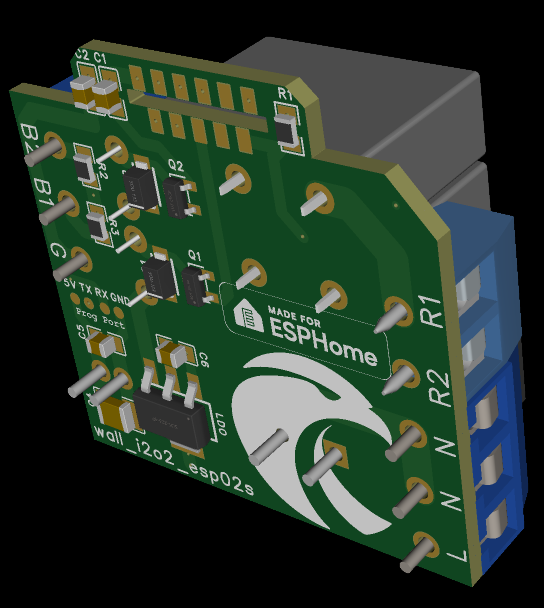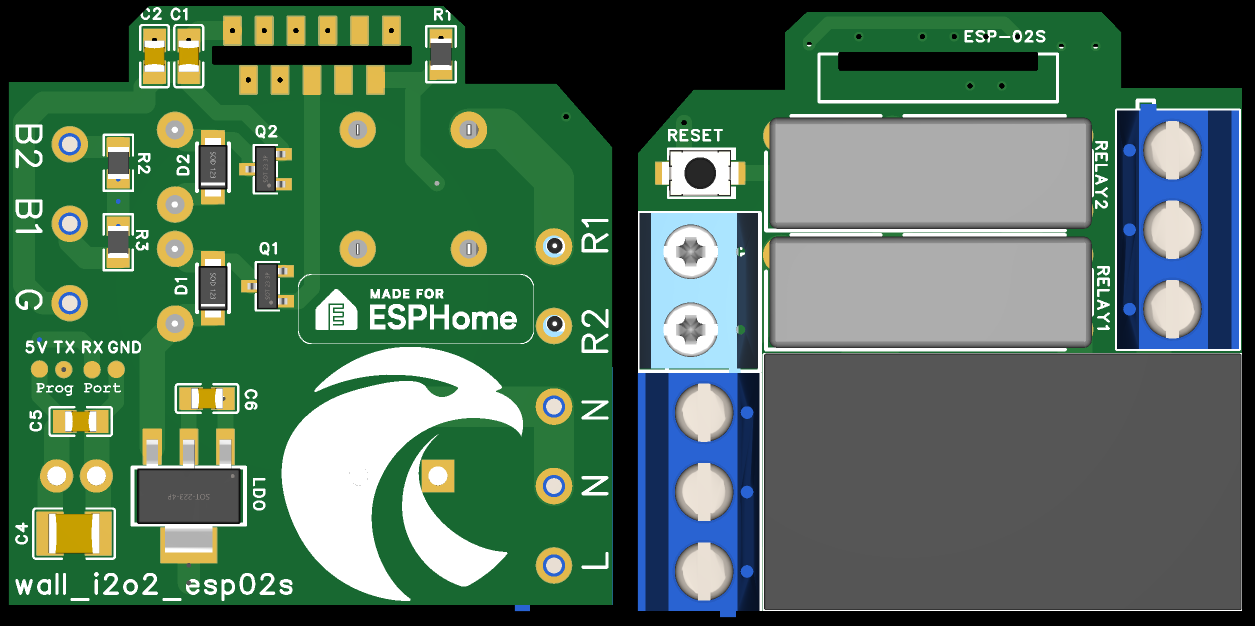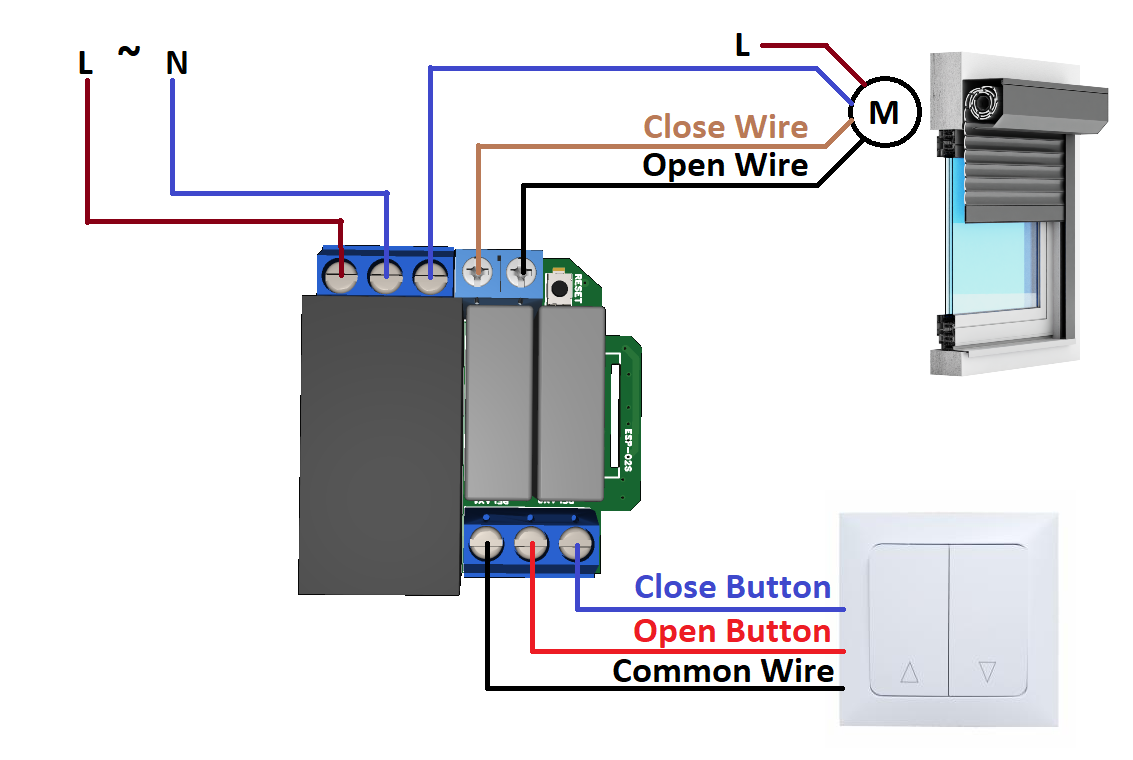Horus - Blind Controller
Description
The Horus Blind Controller allows you to automate and control your blinds using Home Assistant while keeping manual operation via your existing physical switches. It seamlessly integrates with Home Assistant through ESPHome and requires minimal setup.


Features
✅ Works with existing wall switches for manual control
✅ Remote control via Home Assistant
✅ Fully pre-flashed with ESPHome — no extra configuration required
✅ Secure and reliable local communication (no cloud dependency)
✅ Customizable automation rules
Wiring Diagram

YAML Configuration
substitutions:
devicename: "horus-blind"
esphome:
name: ${devicename}
esp8266:
board: esp01_1m
# Enable logging
logger:
# Enable Home Assistant API
api:
ota:
- platform: esphome
password: ""
wifi:
ssid: !secret wifi_ssid
password: !secret wifi_password
# Enable fallback hotspot (captive portal) in case wifi connection fails
ap:
ssid: "Horus-Blind"
password: "esphomearez"
captive_portal:
#*** Web server optional if you whant check or control over http requests ***
#web_server:
# port: 80
# version: 3
# include_internal: true
# ota: false
binary_sensor:
- platform: gpio
pin:
number: 4 # ---
mode: INPUT_PULLUP
inverted: true
filters:
- delayed_on: 50ms
- delayed_off: 50ms
id: button_open_1
on_press:
then:
# logic for cycling through movements: open->stop->close->stop->...
- lambda: |
if (id(my_cover_1).current_operation == COVER_OPERATION_IDLE)
{
id(my_cover_1).open();
id(output_cover_open).turn_on();
}
else
{
id(my_cover_1).stop(); // Cover is opening/closing. Stop it
}
on_release:
then:
- lambda: |
id(my_cover_1).stop(); // Cover is opening/closing. Stop it
- platform: gpio
pin:
number: 5 # ---
mode: INPUT_PULLUP
inverted: true
filters:
- delayed_on: 50ms
- delayed_off: 50ms
id: button_close_1
on_press:
then:
# logic for cycling through movements: open->stop->close->stop->...
- lambda: |
if (id(my_cover_1).current_operation == COVER_OPERATION_IDLE)
{
id(my_cover_1).close();
id(output_cover_close).turn_on();
}
else
{
id(my_cover_1).stop(); // Cover is opening/closing. Stop it
}
on_release:
then:
- lambda: |
id(my_cover_1).stop(); // Cover is opening/closing. Stop it
switch:
- platform: gpio
pin:
number: 14
mode: OUTPUT
inverted: false
id: output_cover_open
- platform: gpio
pin:
number: 13
mode: OUTPUT
inverted: false
id: output_cover_close
cover:
- platform: time_based
name: "Blinds"
id: my_cover_1
open_action:
- switch.turn_on: output_cover_open
- switch.turn_off: output_cover_close
open_duration: 23s #Change this value in orther to match the blind open duration
close_action:
- switch.turn_off: output_cover_open
- switch.turn_on: output_cover_close
close_duration: 22s #Change this value in orther to match the blind close duration
stop_action:
- switch.turn_off: output_cover_open
- switch.turn_off: output_cover_close
Installation
-
Connect the device to the existing blind switch following the wiring diagram.
-
Power on the device—it will automatically create a Wi-Fi hotspot if not connected to your home network.
-
Connect to the hotspot (SSID: ESPHome-XXXXXX), then configure the Wi-Fi settings.
-
Add to Home Assistant using the ESPHome integration.
Home Assistant Integration
-
Navigate to Settings → Devices & Services
-
Click + Add Integration
-
Select ESPHome and enter the device IP address
Automations & Controls
-
Use the physical wall switches for direct control
-
Create automations in Home Assistant to control blinds based on time, weather, or sunlight conditions
Support
For troubleshooting, check the ESPHome logs:
esphome logs smart_blind_controller.yaml